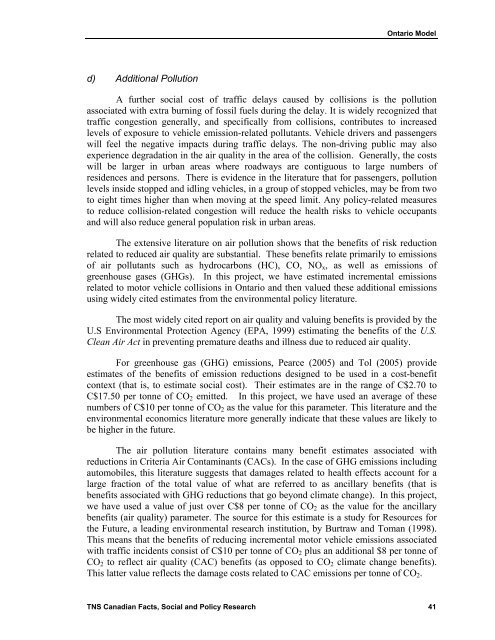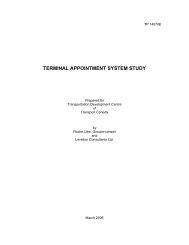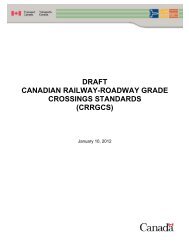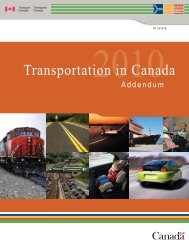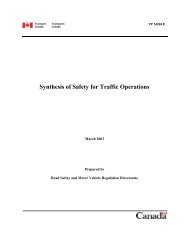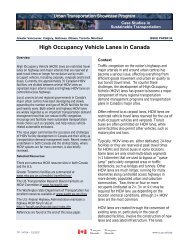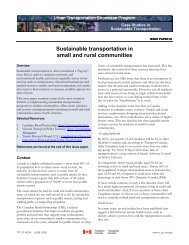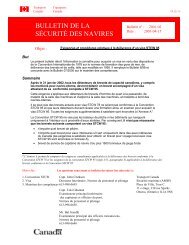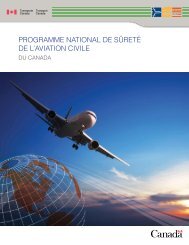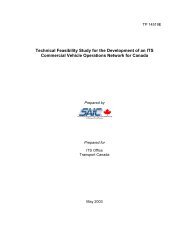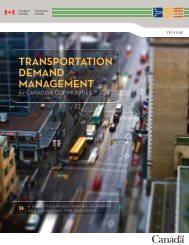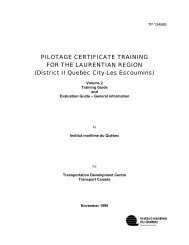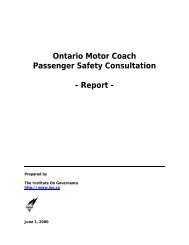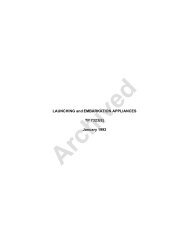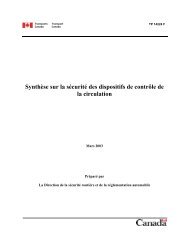Keith Vodden Dr. Douglas Smith - Transports Canada
Keith Vodden Dr. Douglas Smith - Transports Canada
Keith Vodden Dr. Douglas Smith - Transports Canada
You also want an ePaper? Increase the reach of your titles
YUMPU automatically turns print PDFs into web optimized ePapers that Google loves.
Ontario Model<br />
d) Additional Pollution<br />
A further social cost of traffic delays caused by collisions is the pollution<br />
associated with extra burning of fossil fuels during the delay. It is widely recognized that<br />
traffic congestion generally, and specifically from collisions, contributes to increased<br />
levels of exposure to vehicle emission-related pollutants. Vehicle drivers and passengers<br />
will feel the negative impacts during traffic delays. The non-driving public may also<br />
experience degradation in the air quality in the area of the collision. Generally, the costs<br />
will be larger in urban areas where roadways are contiguous to large numbers of<br />
residences and persons. There is evidence in the literature that for passengers, pollution<br />
levels inside stopped and idling vehicles, in a group of stopped vehicles, may be from two<br />
to eight times higher than when moving at the speed limit. Any policy-related measures<br />
to reduce collision-related congestion will reduce the health risks to vehicle occupants<br />
and will also reduce general population risk in urban areas.<br />
The extensive literature on air pollution shows that the benefits of risk reduction<br />
related to reduced air quality are substantial. These benefits relate primarily to emissions<br />
of air pollutants such as hydrocarbons (HC), CO, NO x , as well as emissions of<br />
greenhouse gases (GHGs). In this project, we have estimated incremental emissions<br />
related to motor vehicle collisions in Ontario and then valued these additional emissions<br />
using widely cited estimates from the environmental policy literature.<br />
The most widely cited report on air quality and valuing benefits is provided by the<br />
U.S Environmental Protection Agency (EPA, 1999) estimating the benefits of the U.S.<br />
Clean Air Act in preventing premature deaths and illness due to reduced air quality.<br />
For greenhouse gas (GHG) emissions, Pearce (2005) and Tol (2005) provide<br />
estimates of the benefits of emission reductions designed to be used in a cost-benefit<br />
context (that is, to estimate social cost). Their estimates are in the range of C$2.70 to<br />
C$17.50 per tonne of CO 2 emitted. In this project, we have used an average of these<br />
numbers of C$10 per tonne of CO 2 as the value for this parameter. This literature and the<br />
environmental economics literature more generally indicate that these values are likely to<br />
be higher in the future.<br />
The air pollution literature contains many benefit estimates associated with<br />
reductions in Criteria Air Contaminants (CACs). In the case of GHG emissions including<br />
automobiles, this literature suggests that damages related to health effects account for a<br />
large fraction of the total value of what are referred to as ancillary benefits (that is<br />
benefits associated with GHG reductions that go beyond climate change). In this project,<br />
we have used a value of just over C$8 per tonne of CO 2 as the value for the ancillary<br />
benefits (air quality) parameter. The source for this estimate is a study for Resources for<br />
the Future, a leading environmental research institution, by Burtraw and Toman (1998).<br />
This means that the benefits of reducing incremental motor vehicle emissions associated<br />
with traffic incidents consist of C$10 per tonne of CO 2 plus an additional $8 per tonne of<br />
CO 2 to reflect air quality (CAC) benefits (as opposed to CO 2 climate change benefits).<br />
This latter value reflects the damage costs related to CAC emissions per tonne of CO 2 .<br />
TNS Canadian Facts, Social and Policy Research 41


